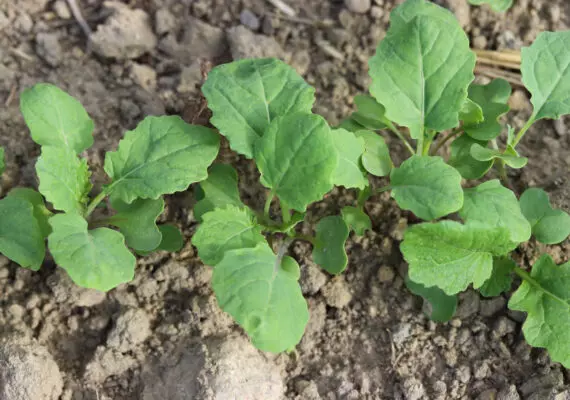
WHAT FERTILIZERS SHOULD BE USED FOR WINTER RAPE?
Winter rapeseed requires proper fertilization. It is necessary to provide it with large amounts of nutrients. They should be delivered at the right time and in the proper dose to ensure the best possible conditions for plant growth throughout the vegetation period. This will allow for obtaining abundant yields of high quality.
Fertilization of winter rapeseed with nitrogen
Fertilization of winter rapeseed with nitrogen should begin in spring. In autumn, the plant absorbs this element in a mineral form resulting from the decomposition of the previous crop. Winter rapeseed can absorb 60–80 kg of nitrogen in this way. It is not advisable to additionally fertilize this plant with nitrate in the autumn, as it may reduce its frost resistance.
It is assumed that winter rapeseed fields are fertilized with nitrogen in two doses in spring. The first one is about 100 kg of nitrogen per hectare. This dose is applied at the turn of February and March, and the second one in the same amount with an interval of 2–4 weeks. It is necessary to monitor weather forecasts to ensure heavy rainfall between nitrogen doses. This will allow the fertilizer to dissolve in the soil and then move deeper into it.
Fertilization of winter rapeseed should be done so that the first dose is delivered before the spring vegetation of the plant begins. The second dose of nitrogen must be applied no later than 4 weeks before the winter rapeseed flowering. It is important to ensure rainfall between the first and second fertilization doses. Subsequent nitrogen fertilization is not recommended, as it contributes to delaying and prolonging flowering. Winter rapeseed becomes more prone to lodging, and the plants are more lush, resulting in a decrease in the quantity and quality of yields.
Fertilization of winter rapeseed with phosphorus
Phosphorus fertilizer should be applied to the field in autumn before sowing winter rapeseed. Phosphorus allows for the proper development of the plant’s root system. Thanks to this, winter rapeseed will be able to better absorb water and nutrients from the soil. Additionally, a strong root system will facilitate its survival during winter.
Assuming that a yield of 4–5 tons of winter rapeseed is desired, before sowing this plant, it is necessary to supply the field with 80 to 110 kg of phosphorus per hectare. Spring fertilization of plants with phosphorus is not usually practiced. Such a spring treatment would contribute to fertilizing plants that will grow after rapeseed.
Fertilization of winter rapeseed with potassium
Fertilization with potassium is best done in two doses – one to be applied before sowing in autumn, and the other in spring before the plant vegetation begins. This procedure can be carried out in proportions of 50% or 75% and 25% to supply a total of 300 to 360 kg of potassium per hectare. Winter rapeseed absorbs this element in the largest quantities because it is crucial for the formation of the rosette and the plant’s resistance. It is best if the potassium fertilizer has time to dissolve and move deep into the soil. This is important because winter rapeseed absorbs about 60% of potassium from deeper soil layers.
Fertilization of winter rapeseed with sulfur
Fertilization of winter rapeseed with sulfur reduces the risk of crop damage by pathogenic factors. Before sowing, sulfur should be applied to the field at a rate of 15 to 20 kg per hectare. This allows the plants to overwinter better and utilize nitrogen more effectively. Subsequent fertilization with sulfur should be done in spring. The spring dose must be calculated about the nitrogen fertilizer at a ratio of 5:1. If the field is supplied with 180 kg of nitrogen per hectare, then 36 kg of sulfur per hectare should be applied.
Due to significant leaching, sulfur should be applied both in autumn (before sowing) and in spring along with nitrogen fertilizer.
Fertilization of winter rapeseed with magnesium
Magnesium is a nutrient that easily leaches from the soil, so it is necessary to fertilize it both in autumn (on poor soils) and in spring. Magnesium is an essential component for the proper growth of winter rapeseed.
Magnesium fertilization should be divided into two doses. In the first, autumn dose, about 15–20 kg of magnesium oxide per hectare should be applied. The next dose should be applied in early spring, before nitrogen fertilization. It is best to use a fast-acting, water-soluble magnesium-sulfur fertilizer. The second dose should be about 50 kg of magnesium oxide. It is extremely important to annually replenish magnesium deficiencies in the soil.
Microelements in winter rapeseed fertilization
In addition to fertilizing with macroelements for winter rapeseed cultivation, it is very important to supply plants with microelements – most often in the form of soil or foliar application. Foliar fertilization of winter rapeseed should be done by applying boron, manganese, and molybdenum. Then, copper, zinc, and iron should be applied foliarly. Microelements should be applied in spring.
Boron is responsible for the development of the root system and preventing the formation of empty spaces in the main root. It reduces the risk of stem cracking and supports the formation of pollen tubes and seed setting. The required amount of boron is from 600 to 1000 g per hectare. It should be applied in three doses.
Microelements that support resistance to diseases in winter rapeseed, improve photosynthesis, and regulate the plant’s hormonal balance and nitrogen management, are manganese, copper, and zinc. Manganese should be applied at a rate of 360 to 900 g per hectare, copper from 45 to 135 g per hectare, and zinc from 225 to 675 g per hectare.
Molybdenum helps to incorporate nitrogen into the plant’s protein structures. It also supports hormonal balance and helps the plant to regenerate faster after the winter period. Molybdenum should be applied at a rate of 36 to 45 g per hectare.
Iron is the most absorbed microelement by winter rapeseed. It should be applied at a rate of 900 to 1800 g per hectare. It is best to divide the iron application into two treatments. The first one should be done at the rosette stage, and the second one when the plant enters the budding stage. Iron helps to create stronger tissues, increases resistance to lodging, and protects against diseases.
Foliar feeding of winter rapeseed is usually done with a solution containing several elements. Some foliar feeding treatments can be carried out in autumn when the plant has 6–8 leaves, and the rest in spring.
NUTRITIONAL REQUIREMENTS OF WINTER RAPE
It is worth remembering that winter rapeseed fertilization should be carried out to achieve the desired yield. If it is assumed that the goal is to obtain 4.5 tons of rapeseed per hectare, you need to be prepared for the rapeseed to absorb from that hectare:
- about 250–270 kg of nitrogen;
- about 110–135 kg of phosphorus pentoxide;
- about 315–360 kg of potassium oxide;
- about 180–225 kg of calcium oxide;
- about 45–60 kg of magnesium oxide;
- about 50 kg of sulfur, which is 125 kg of sulfur trioxide;
- about 900–1800 g of iron;
- about 360–900 g of manganese;
- about 225–675 g of zinc;
- about 45–135 g of copper;
- about 36–45 g of molybdenum;
- about 600–1000 g of boron.
The soil on which winter rapeseed grows should have a pH ranging from 6.0 to 7.0. The heavier the soil, the closer its pH should be to 7.0.

LIMING THE WINTER RAPE FIELD
Lime not only allows for obtaining the proper soil pH but is also a very necessary nutrient for plants, which, among other things, allows them to absorb other elements from the soil. The optimal soil pH for winter rapeseed is from 6.0 to 7.0. With the presence of lime in the soil, winter rapeseed will have a deep and well-developed root system. It will also become more resistant to fungal diseases, and its growth will proceed correctly. The optimal lime dose for winter rapeseed should therefore be from 180 to 225 kg per hectare. It is best to lime the field during the pre-crop period. However, if this has not been done, it is possible to apply lime interventively, after sowing. It is best to use powdered or granulated calcareous lime for this purpose. Granulated calcareous lime, which can be used for liming the winter rapeseed field in autumn, winter, and spring, is particularly worth attention.
Polcalc III Generation and SuperMag work very well in this case. They can be used both post-sowing and „under the aggregate.” Thanks to moisture and rainfall, the fertilizer is evenly distributed and acidifies the soil. These fertilizers are completely safe for plants, so they do not pose a threat to them when applied post-sowing, or even when applied directly to green areas. The maximum dose of the fertilizers mentioned above recommended is from 500 to 1000 kg per hectare.
WHAT NOT TO SOW AFTER RAPE?
The basic rule when sowing rapeseed is not to sow it in the same place year after year. However, it is an excellent predecessor for winter wheat.
Growing rapeseed year after year in the same field contributes to the accumulation of pests, including cabbage stem flea beetle or turnip sawfly, as well as weeds. The plantation may also be at risk of clubroot. It is best to keep a three-year gap between rapeseed cultivation and other species belonging to the cabbage family in the same field.






